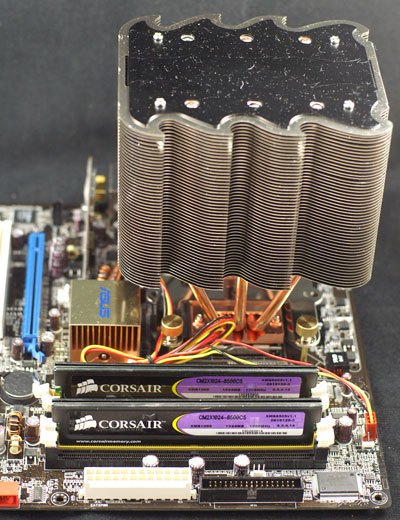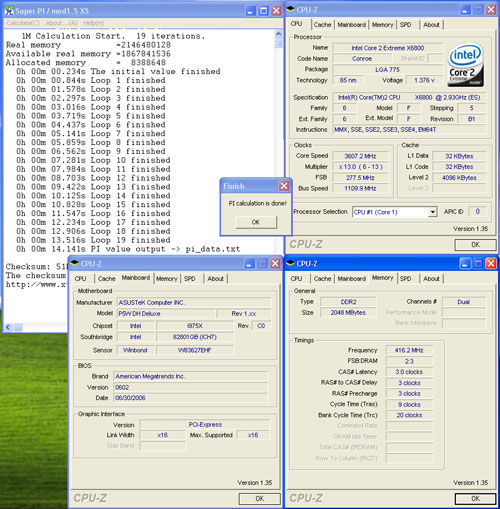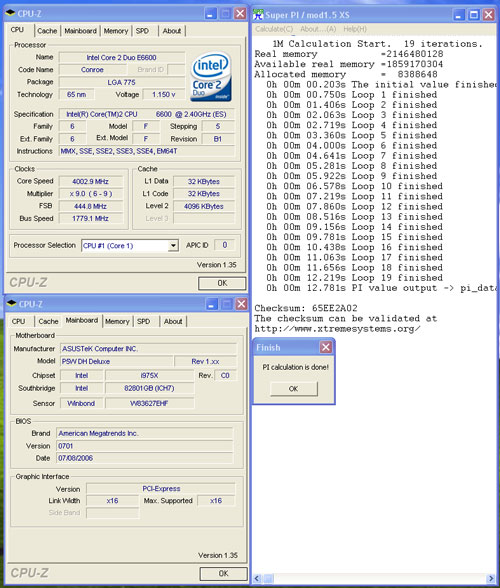Intel's Core 2 Extreme & Core 2 Duo: The Empire Strikes Back
by Anand Lal Shimpi on July 14, 2006 12:00 AM EST- Posted in
- CPUs
Overclocking
You have already seen that the Core 2 Extreme X6800 outperforms AMD's fastest processor, the FX-62, by a wide margin. This is exacerbated by the fact that the $316 E6600, running at 2.4GHz, outperforms the FX-62 in almost every benchmark we ran. That certainly address the questions of raw performance and value.
For most enthusiasts, however, there is also the important question of how Core 2 processors overclock. As AMD has moved closer to the 90nm wall, recent AM2 processors do not have much headroom. A prime example is the FX-62, which is rated at 2.8GHz, reaches 3GHz with ease, but then has a difficult time reaching or passing 3.1GHz on air. So how does Core 2, built at 65nm, compare in overclocking?
The top X6800 is rated to run at 11X multiplier on a 1066MHz FSB; it is the only Core 2, however, that is completely unlocked, both up and down. You can adjust multipliers up to 60 on the Asus P5W-DH motherboard, or down to 6. This makes the X6800 an ideal CPU for overclocking, even though top-line processors are normally notorious for not being the best overclockers.
To gauge the overhead or overclocking abilities of the X6800 in the simplest terms, the CPU speed was increased, keeping the CPU voltage at the default setting of 1.20V.
At default voltage the X6800 reached a stable 3.6GHz (13 x277). This is a 23% overclock from the stock 2.93GHz speed at stock voltage. It is also an important overclocking result, since it implies Intel could easily release a 3.46GHz or 3.6GHz Core 2 processor tomorrow if they chose to. It is clear there is no need for these faster Core 2s yet, but it does illustrate the speed range possible with the current Core 2 Duo architecture.
The X6800 was then pushed to the highest CPU speed we could achieve with Air Cooling. We did use a very popular and effective air cooler for our testing, the Tuniq Tower.

The goal was to reach the highest possible speed that was benchmark stable. Super Pi, 3DMarks, and several game benchmarks were run to test stability. The 2.93GHz chip reached 4.0GHz on air cooling in these overclocking tests. That represents a 36% overclock on air with what will likely be the least overclockable Core 2 processor - the top line X6800.
To provide some idea of overclocking abilities with other Core 2 Duo processors, we ran quick tests with E6700 (2.67GHz), and E6600 (2.4GHz). The test E6700 reached a stable 3.4GHz at default voltage and topped out at 3.9GHz with the Tuniq Cooler. The 2.4GHz E6600 turned out to be quite an overclocker in our tests. Even though it was hard-locked at a 9 multiplier it reached an amazing 4GHz in the overclocking tests. That represents a 67% overclock.
We had another Core 2 Extreme X6800 that we tried overclocking with a stock Intel HSF. The results were not as impressive as with the Tuniq cooler, with 3.4GHz being the most stable we could get it. We're going to be playing around with these processors more in the future to hopefully get a better overall characterization of what you can expect.
Curious about our overclocking successes, we asked Intel why Core 2 CPUs are able to overclock close to the same levels as NetBurst processors can, despite having less than half the pipeline length. Intel gave us the following explanation:
NetBurst microarchitecture is constrained by physical power / thermal limitations long before the constraint of pipeline stages comes into play. The microarchitecture itself would continue to scale upwards if not for the power constraints. (In fact, we have seen Presler overclocked to 6 GHz in liquid nitrogen environments. At that level, power delivery through the power supply & board itself begin to limit further scaling of the processor.)
Intel's explanation makes a great deal of sense, especially when you remember the original claims that NetBurst was supposed to be good for between 5GHz - 10GHz. NetBurst never got the chance to reach its true overclocking prime as Intel hit thermal density walls well before the 5GHz - 10GHz range and thus Intel's Core architecture was born. Intel's Core 2 processors once again give us an example of the good ol' days of Intel overclocking, where moving to a smaller manufacturing process meant we'd have some highly overclockable chips on our hands. With NetBurst dead and buried, the golden age of overclocking is back.
Enthusuasts have not seen overclocking like this since Socket 478 days, and in fact Core 2 may be even better. The 2.4GHz E6600, which outperformed the FX-62 in most benchmarks at stock speed costs $316, and overclocked to 4Ghz with excellent air cooling. With that kind of performance, value, and overclocking the E6600 will likely become the preferred chip for serious overclockers - particularly those that are looking for champagne performance on a smaller budget.
It is important, however, not to sell the advantages of the X6800 short. AnandTech never recommends the fastest chip you can buy as a good value choice, but X6800 does bring some advantages to the table. It is the only Conroe that is completely unlocked. This allows settings like 266(stock FSB)x15 for 4.0GHz, settings that keep other components in the system at stock speed. This can only be achieved with the X6800 - other Core 2 Duo chips are hard-locked - and for some that feature will justify buying an X6800 at $999. For the rest of us overclockers E6600 is shaping up to be the chip to buy for overclocking.












202 Comments
View All Comments
crystal clear - Saturday, July 15, 2006 - link
Just to remind all that-" Intel decides to release a B2 stepping of its Conroeprocessors.Also
BEWARE of Engineering samples & reviews based on Engineering samples inlcuded.
OcHungry - Saturday, July 15, 2006 - link
I don’t know if this Q been asked or answered (sorry no time reading 120 posts)Bu Mr. Anand, can I kindly ask you couple of concerns:
1) why don’t we see any reference to temp. under load? Temp. is a crucial factor in deciding wether or not I buy conroe since I live in a very hot climate.
2)A lot people make reference to 64bit and window vista and that conroe is a 32bit architecture and will not perform as good in 64bit. Is it true? can we have some 64bit benchmarks? It would be great to do this test in multitasking.
3) I have also noticed (from so many who have had pre-release ES @ XS, and other forums) that overclocked conroe does not correspond directly to performance, unlike A64.
What I mean is: If A64 is overclocked 20%, the performance increases ~20% 9more or less, in most cases), But have not seen this to hold w/ conroe. So I am wondering what would happen if we put a low end conroe, such as E6400 against A64 4000 x2, 2x1mb cache (same price range after price drop) and overclock them to their limit, using stock cooling, and do the benchmarks (64bit included). The reason I am interested in this type of review is because I am an average end user on budget and would like to know which would give me better price/performance. I think I am speaking for at least 90% of consumers. Not everyone buys $1000 cpu and consumers on budget is detrimental to survival of conroe or AM2 cpus. This alone should give you enough incentive to put together a review oriented around us, the mainstream computer users. We can make or break any chipmaker.
So please Mr. Anad, can we have another review along those lines described above?
We greatly appreciate it.
Thanks,
ochungry
aznskickass - Saturday, July 15, 2006 - link
Hey ochungry, I believe Xbitlabs did an overclocking comparison between a Conroe E6300 and an A64 X2 3800+, and while they didn't do any 64bit benchmarks, the conclusion is that at stock speeds the E6300 is slightly faster than X2 3800+, and when both are overclocked to the max, E6300's lead increases even more.Here is the review/comparison:
http://xbitlabs.com/articles/cpu/display/core2duo-...">http://xbitlabs.com/articles/cpu/display/core2duo-...
OcHungry - Saturday, July 15, 2006 - link
Those guys @ X-bit lab do not fool me. And I hope Anandtech conducts the same test w/ best suited memory module for “BOTH” platforms. We know (so as Xbitlab knows) that, because of IMC, A64 performs its best @ tightest memory timings. X-bit lab should have used http://www.newegg.com/Product/Product.asp?Item=N82...">This memory module if the test was going to be fair and square. Furthermore A64 3800 x2 @ 3ghz is 10x300, which means DDR2 667 1:1 could have been better to use. This http://www.newegg.com/Product/Product.asp?Item=N82...">DDR2 667 @ 3-3-3-10 would have given about 10% better performance than DDR2 4-4-4-12 that they used. X-bit does not mention anything about memory/cpu ratio. What divider was used? Was it 133/266? Or as close to 1:1 as possible? Sooner or later the truth will prevail when we end users try it for ourselves (oh BTW, not ES), and we will see if xbitlab and others were genuinely interested on behalf of consumers, or the interest destined to ill-fated purpose. Will not accuse anyone, but it all look very fishy.I am certain that Mr. Anad will clear all these conspicuous reviews , and hand us another that concerns the consumer’s majority- us average users.
IntelUser2000 - Saturday, July 15, 2006 - link
W-R-O-N-G!!! DDR2-800 at EVEN slower 5-5-5-15 timings is FASTER THAN DDR2-667 3-3-3-10: http://xbitlabs.com/articles/cpu/display/amd-socke...">http://xbitlabs.com/articles/cpu/display/amd-socke...
Prefer AT's results?: http://www.anandtech.com/cpuchipsets/showdoc.aspx?...">http://www.anandtech.com/cpuchipsets/showdoc.aspx?...
DDR2-800 is faster. The myth that it performs amazingly better(comparatively) with lower latency is just, a myth. I believe there was a thread in forums that tells exactly that.
OcHungry - Sunday, July 16, 2006 - link
Iguess you don’t understand much about AMD's memory latency, direct connect, and 1:1 ratio.It is not like Intel's illusionary, that faster than FSB is better. It is not and is useless. Anad proved it here. But this subject has a tendency to be dragged on for ever by those who don’t understand the concept of IMC. So it's better leave it alone.
But I still would like to see tightest timing and 1:1 ratio. It is now clear to me that those reviews in favor of Intel, artfully evade this argument/request, knowing it will give AMD advantage over Intel's FSB.
aznskickass - Sunday, July 16, 2006 - link
*sigh*How is the AMD disadvantaged if BOTH platforms are reviewed using the same RAM?
AMD needs ultra low latency DDR2 to attain best performance? Well, bad luck, Intel doesn't , there is no 'deliberate' conspiracy to put AMD in a bad light.
Look, if you just want to hang on to the notion that AMD has been cheated in the reviews, then go ahead and get your X2 4200+ and see how close you can get to Conroes numbers.
I'll be using my E6600 @ 3.5GHz+ and laughing at your stupidity.
aznskickass - Saturday, July 15, 2006 - link
I consider Xbitlabs to be one of the more trustworthy sites around, and do note that they are testing mainstream chips, and expensive CL3 DDR2 just doesn't make sense in a budget setup, which further puts Conroe in a good light, as it doesn't require expensive CL3 DDR2 to perform well.sum1 - Friday, July 14, 2006 - link
A good read. For the editor, I found 4 errors, search the full lines of text below at:http://www.anandtech.com/printarticle.html?i=2795">http://www.anandtech.com/printarticle.html?i=2795
That begin said,
and H.264 in coding
as soon as its available
at the fastest desktop processor we've ever tested
("and" would be more readable that "at" in this sentence)
JarredWalton - Friday, July 14, 2006 - link
Thanks. At least one of those (in coding) can be blamed on my use of Dragon NaturallySpeaking and not catching the error. The others... well, they can be blamed on me not catching them too. LOL. The last one is sort of a difference of opinion, and I've replaced the comma with a dash, as that was the intended reading. :)--Jarred